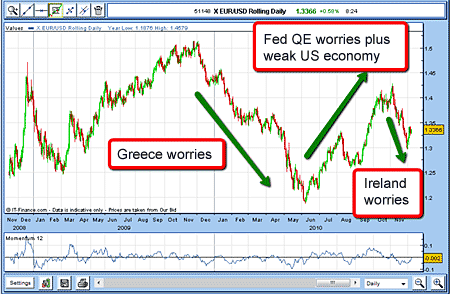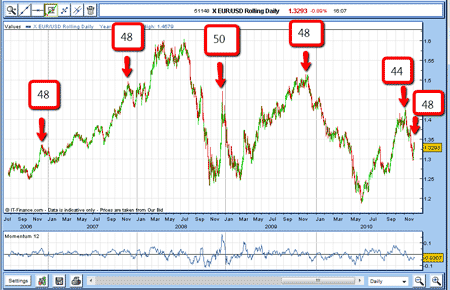Trading currencies in the era of quantitative easing
In the era of quantitative easing, we will see wide swings in currency values. My strategy is to trade these swings. Here's how.
Since the credit crisis of 2007-2009 brought an abrupt end to decades of unprecedented credit expansion in the world's economies, currencies have been engaged in a race to the bottom.
Confidence in 'paper currencies' has taken a severe knock. Belief in gold's role as a store of value continues to climb. At the time of writing, gold is trading at well over $1,400 a record high (in dollar terms).
As the focus of market attention swings from the US Federal Reserve policy of quantitative easing (QE money printing) and dollar debasement, to the sovereign debt problems in the eurozone, the EUR/USD rate has swung around in some very large moves.
MoneyWeek
Subscribe to MoneyWeek today and get your first six magazine issues absolutely FREE

Sign up to Money Morning
Don't miss the latest investment and personal finances news, market analysis, plus money-saving tips with our free twice-daily newsletter
Don't miss the latest investment and personal finances news, market analysis, plus money-saving tips with our free twice-daily newsletter
Watching the market in 2010 has been like watching a very long rally at Wimbledon (as the chart below demonstrates)! The Greek crisis sent the euro tumbling, only to rally as attention switched to the US and prospects for more QE. Then Ireland's woes hit the headlines, and it was the euro's turn to fall again.

How to profit from these big swings
For investors who base their investment decisions on 'fundamental' analysis, 2010 must be proving one of the toughest years in history. But for technical traders like me, this year has offered some of the very best trading conditions ever.
So, what tools am I using to catch these big swings? Before I tell you, I will point out that in trading, there are many ways to skin a cat. Although my methods are working for me, there are different methods that work for others. With that disclaimer out of the way, here goes.
The first thing I realised is that in the QE era, we will see wide swings. So my strategy is to trade these swings, and not hold positions looking for that big 'home run'. My trades will ideally last from a few days to a few weeks.
The unsuccessful ones will be over in hours, as my protective stops are hit.
I am using my usual Elliott wave and Fibonacci methods, combined with momentum indicators and of course, my tramline trading method (you can read more about all of these in the glossary and also in my previous blog posts).
Also, I am keeping an eye on sentiment readings, as these have been swinging from one record extreme to the other. (The excellent trade-futures.com organisation surveys on a daily basis the bull/bear attitudes of its members who trade the S&P futures the E-mini S&P is the most heavily traded contract. It then publishes a ten-day moving average of sentiment. The extreme readings we have seen this year in both directions are records. I believe this is a very accurate measure of sentiment, as it surveys actual independent traders who are staking their own money).
But there is one more tool I can use. And it's not one that is widely recognised.
A 12-month cycle in the EUR/USD
Below is the weekly chart going back a few years showing a very interesting feature. Since 2005, the EUR/USD has made a significant top in Week 48 in every year, including 2010, if you allow for the rather earlier top made in Week 44.

The market is exhibiting definite cyclic behaviour. (Incidentally, in cycle analysis, if a top comes in early, that is usually a bearish signal).
The study of market cycles can be very involved, but one feature that seems universal is that no cycle lasts forever. When a particular cycle becomes too well-known, that's when it stops working.
But whatever forces are driving this behaviour (it could be connected with trade, or book-squaring by banks and other institutions), there is a definite tendency for the market to move down at year-end and into the New Year.
It holds when the dollar is in a bull phase, or a bear phase (at least it has for the past five years).
Reviewing 2010, 2009 ended with the euro having made a high at $1.5150 with 10-Day Sentiment having climbed to 90% bulls. Then worries over Greece turned the market around. The euro fell to $1.19 by June a fall of over 20% in six months and the ten-day sentiment reading plunged to less than 10% euro bulls. Talk about a manic-depressive market!
In the summer, the market switched attention to the Fed's QE programme. The euro rallied back to the $1.43 area a gain of 20% in four months by which point, the ten-day sentiment reading had climbed back to over 90% euro bulls.
When sentiment readings get so extended, you know a turn is near. That is because the vast majority of traders join the herd and do what all the others do. If the majority are bearish the dollar, most traders join in the fun until there are no more to join the party. They believe in safety in numbers. Meanwhile, opinion is still massively one-sided at the tops.
As a swing trader, we need to trade against the herd and be ready to trade against the trend. This takes courage. Market tops and bottoms are, by definition, never recognised by the vast majority. They take most by surprise. As is well said: "Nobody rings a bell at tops or bottoms".
Get the latest financial news, insights and expert analysis from our award-winning MoneyWeek team, to help you understand what really matters when it comes to your finances.
John is is a British-born lapsed PhD physicist, who previously worked for Nasa on the Mars exploration team. He is a former commodity trading advisor with the US Commodities Futures Trading Commission, and worked in a boutique futures house in California in the 1980s.
He was a partner in one of the first futures newsletter advisory services, based in Washington DC, specialising in pork bellies and currencies. John is primarily a chart-reading trader, having cut his trading teeth in the days before PCs.
As well as his work in the financial world, he has launched, run and sold several 'real' businesses producing 'real' products.
-
 My 6.5% Nationwide regular saver is due to mature - what are my options?
My 6.5% Nationwide regular saver is due to mature - what are my options?Nationwide’s 6.5% regular saver is due to mature for those who opened one last year. Here is what you can do now to make the most of your savings
-
 Leading European companies offer long-term growth
Leading European companies offer long-term growthOpinion Alexander Darwall, lead portfolio manager, European Opportunities Trust, picks three European companies where he'd put his money